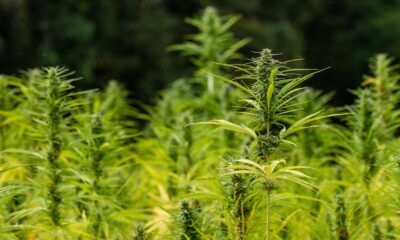Politics
Mitch McConnell Directs DEA To Figure Out How To Distinguish Hemp From Marijuana

Senate Majority Leader Mitch McConnell (R-KY) inserted language into a spending bill report on Thursday directing the Drug Enforcement Administration (DEA) to develop technology that can distinguish hemp from its “illicit cousin” marijuana.
The provision, which was attached to legislation to fund the Department of Justice for Fiscal Year 2020, is meant to support hemp manufacturers and regulators who must ensure that the crop is at or below a 0.3 percent THC content—the legal definition of hemp under the 2018 Farm Bill.
McConnell championed a measure in the wide-ranging agriculture legislation that federally legalized hemp and its derivatives, and he’s since devoted significant efforts to securing protections for the industry. For example, he backed provisions added to a separate appropriations bill last week that provides funding for the U.S. Department of Agriculture to implement hemp regulations.
.@senatemajldr McConnell secured measure to support @DEAHQ's efforts to develop technology to enable law enforcement to distinguish b/t #hemp & marijuana. Provision directs DEA to identify or develop on-the-spot field testing technologies for this purposehttps://t.co/xTbNEPoTOD pic.twitter.com/QsU70ivdJn
— Senator McConnell Press (@McConnellPress) September 26, 2019
“The Committee is aware that law enforcement and other agencies need to have access to laboratory testing and on-the-spot field testing technologies and devices to distinguish between hemp and marijuana,” McConnell’s report language states.
The panel notes current DEA research on the issue and is directing the agency to “report back to the Committee not later than 180 days after enactment of this act, and not less than every 6 months thereafter, until such time as technologies are identified and deployed to law enforcement in the field.”
“I stand ready to work with Kentucky’s hemp producers to address whatever challenges arise as they explore the full potential of this remarkable crop,” McConnell said of his latest provision. “Ensuring law enforcement can differentiate between industrial hemp and its illicit cousin is critical, and I’ll continue working with the DEA and other federal agencies so hemp can be treated the same as any other legal commodity.”
The measure, according to a McConnell press release, directs DEA to “to identify or develop on-the-spot field testing technologies” that would “enable law enforcement to distinguish between hemp and marijuana.”
The Senate Appropriations Committee approves @senatemajldr Mitch McConnell’s requests to address #Kentucky’s priorities, which includes funding to help fight the #AsianCarp infestation in Western Kentucky and to support Kentucky’s #hemp program: https://t.co/xTbNEPoTOD
— Senator McConnell Press (@McConnellPress) September 26, 2019
DEA said in March that it was soliciting help to develop a device that can “provide specificity” in telling the cannabis cousins apart.
A separate provision in the new report “directs DEA to ensure the subsequent drug codes and scheduling guidance for marijuana (cannabis) and marijuana extracts shall be updated to reflect” the removal of hemp as a controlled substance.
In May, McConnell also added language to a disaster relief funding bill clarifying that hemp farmers are entitled to federal crop insurance.
Besides his hemp-specific advocacy, the senator has pushed the Food and Drug Administration (FDA) to develop rules allowing one of the crop’s derivatives, CBD, to be marketed as a food item or dietary supplement.
He asked the head of the FDA in a letter this month to clear a path for the lawful marketing of CBD products, urging the department to issue enforcement discretion guidelines so that CBD businesses know FDA will only target seriously bad actors as it develops long-term regulations.
Red the full language of the funding bill’s hemp provisions below:
Hemp Farming Act Guidance.—The Committee notes that the Agriculture Improvement Act of 2018 removed hemp and its derivatives from the Controlled Substances Act. The Committee appreciates DEA’s Notice on August 27, 2019, affirming the legal status of hemp, including hemp plants and cannabidiol [CBD] preparations at or below the 0.3 percent delta-9 tetrahydrocannabinol [THC] threshold, and directs DEA to ensure the subsequent drug codes and scheduling guidance for marijuana (cannabis) and marijuana extracts shall be updated to reflect this removal.
Hemp Testing Technology.—The Agriculture Improvement Act of 2018 removed hemp and its derivatives from the Controlled Substances Act, and authorized the production, consumption and sale of hemp and hemp-derived products in the United States. The Act requires random testing to ensure hemp meets the definition under the law of having a delta-9 THC concentration of less than 0.3 percent. The Committee is aware that law enforcement and other agencies need to have access to laboratory testing and on-the-spot field testing technologies and devices to distinguish between hemp and marijuana. The Committee is aware that DEA is conducting research in this area and has received responses to a Request for Information to identify any technology in the marketplace capable of providing field test kits. The Committee directs the DEA to continue to work to identify and/or develop such devices and technologies. The Committee further directs the DEA to report back to the Committee not later than 180 days after enactment of this act, and not less than every 6 months thereafter, until such time as technologies are identified and deployed to law enforcement in the field.
This story was updated to note the correct funding legislation that the hemp provision is attached to and to include the full language.
USDA Official Says There Are ‘Challenges’ Giving Hemp Farmers Insurance Coverage
Photo courtesy of Pixabay.















